An emoji is a small graphic illustrated icon — such as a pictogram, logogram, ideogram, or “smiley” — which is embedded in text and used in electronic messages and Internet web sites in order to fill in emotional cues which are otherwise missing from texts or typed conversation; and its name is derived from Japanese: e means picture and moji means character…
The Most Popular Emoji in Each Country Around the World
…but what are the most popular emojis in each country around the world?
To find out the answer to that question, the Twitter application programming interface — or API — was used to retrieve 9 million geotagged tweets. Based on this sample, the most used emoji worldwide and for certain countries with available data was determined.
The maximum number of messages on Twitter from the same account was limited to one per day in order to exclude what are known as bots. “Unique appearances” were then used to calculate the frequency of an emoji in the sample, which means that — for messages on Twitter which have the same emoji more than once — only the first occurrence towards the total usage of that emoji was counted.
For the states of the United States, the most used emoji above the national average — the sum of all states — was selected.
No data was available for the following countries and territories:
- Bahrain
- Cape Verde
- Comoros
- Eritrea
- Grenada
- Kiribati
- Maldives
- Marshall Islands
- The Federated States of Micronesia
- Monaco
- Palestine
- Saint Vincent and the Grenadines
- Samoa
- South Sudan
- Tuvalu
The data was retrieved during the last two weeks of February 2022.
This article from Crossword-Solver gives more details about what are the most used emojis in countries worldwide; and I have been given express written permission to use the graphs and the verbatim text from the aforementioned article in this article. While Crossword-Solver has endeavored to ensure the information provided is accurate and current, it cannot guarantee it, as this information is general in nature only and does not constitute personal advice. Neither Crossword-Solver nor The Gate accept any liability — and assume no responsibility — for any and all information which is presented in this article.
With that disclaimer out of the way, here is the article.
What Are the Most Used Emojis on Twitter in Countries Worldwide?
Some say the emoji is a new universal language: a “pop Esperanto” for the worldwide web. But the meanings of these playful pictograms are more diverse than you might think.
Like any widespread language, ordinary users develop their own emoji vernacular and interpret the imagery through their own cultural lens. In China, for example, the clapping hands symbol is just as NSFW as the corn is on TikTok (to TikTok users, the corn emoji does not mean corn).
Meanwhile, like any language, the standardization of emojis is political. The make-up of the Unicode Consortium, which chooses new emojis, underrepresents (and further marginalizes) marginalized groups. And it over-represents the biggest tech companies, who buy expensive voting memberships on the board. Naturally, efforts to improve representation are always fraught with controversy!
Words are our business at Crossword-Solver, so we wanted to learn more about this booming form of communication that neglects to use words at all. We analyzed geotagged tweets from every country in the world to see which emojis are used the most from place to place. And we made maps of our results… because sometimes it helps to visualize what you’re trying to say.
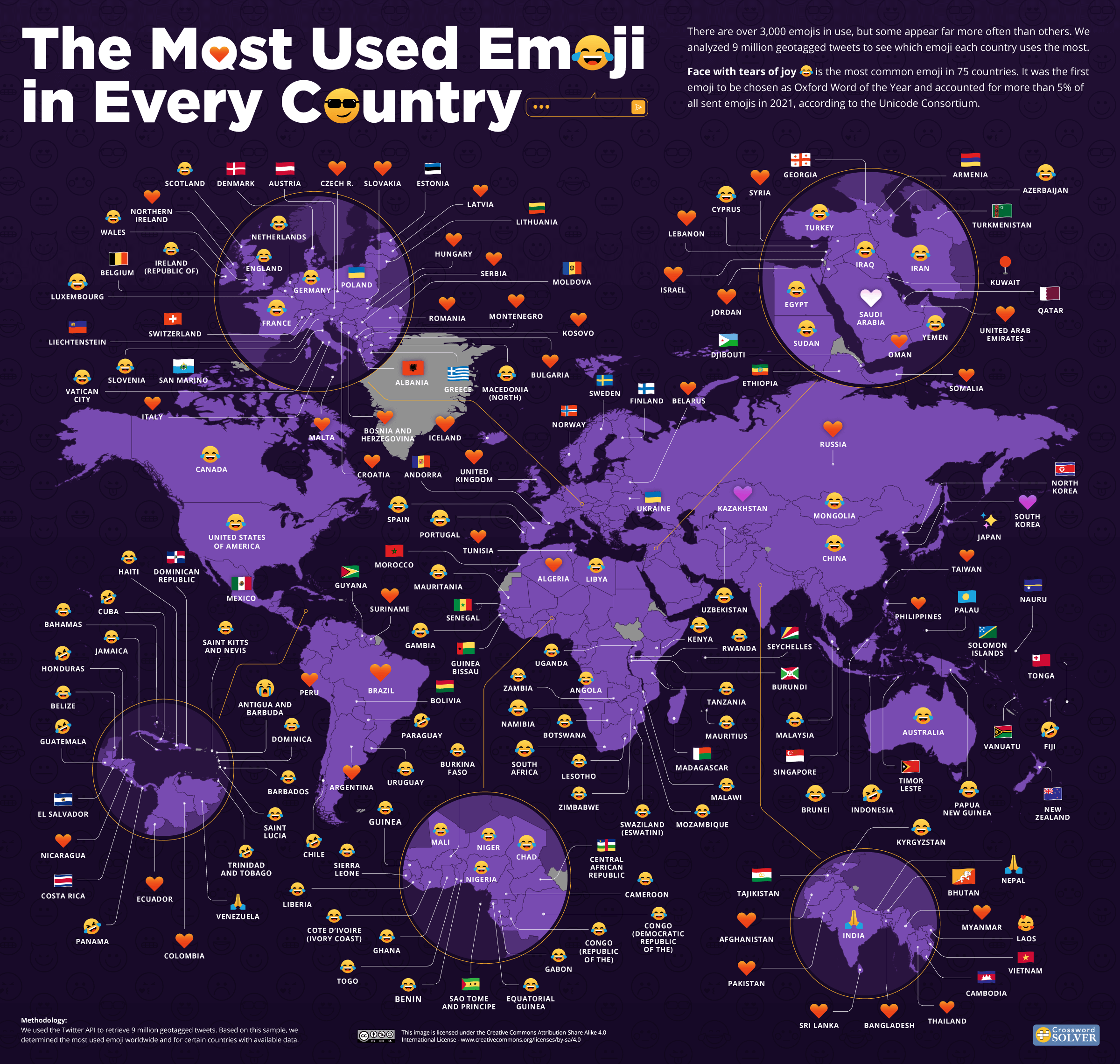
Key Findings
- Most countries are either laughing or loving as face with tears of joy 😂 and red heart ❤️ are the first and second most used emojis worldwide.
- Face with tears of joy 😂 is the most common emoji in 75 countries.
- Wordle-themed emojis 🟩 🟨 ⬜ find their way into America’s top ten most-used emojis.
- Emojis are not a universal language. In China the clapping hands emoji 👏 suggests “making love,” while sending thumbs up👍 to a Greek may cause offence.
North America
The most common emoji in the U.S. is also the most common national number one in the world. The face with tears of joy is the go-to emoji to express uncontrolled laughter, while the tears make it suitable for use in a self-deprecating way, too. It has previously been revealed as the most-used emoji on Facebook and Instagram.
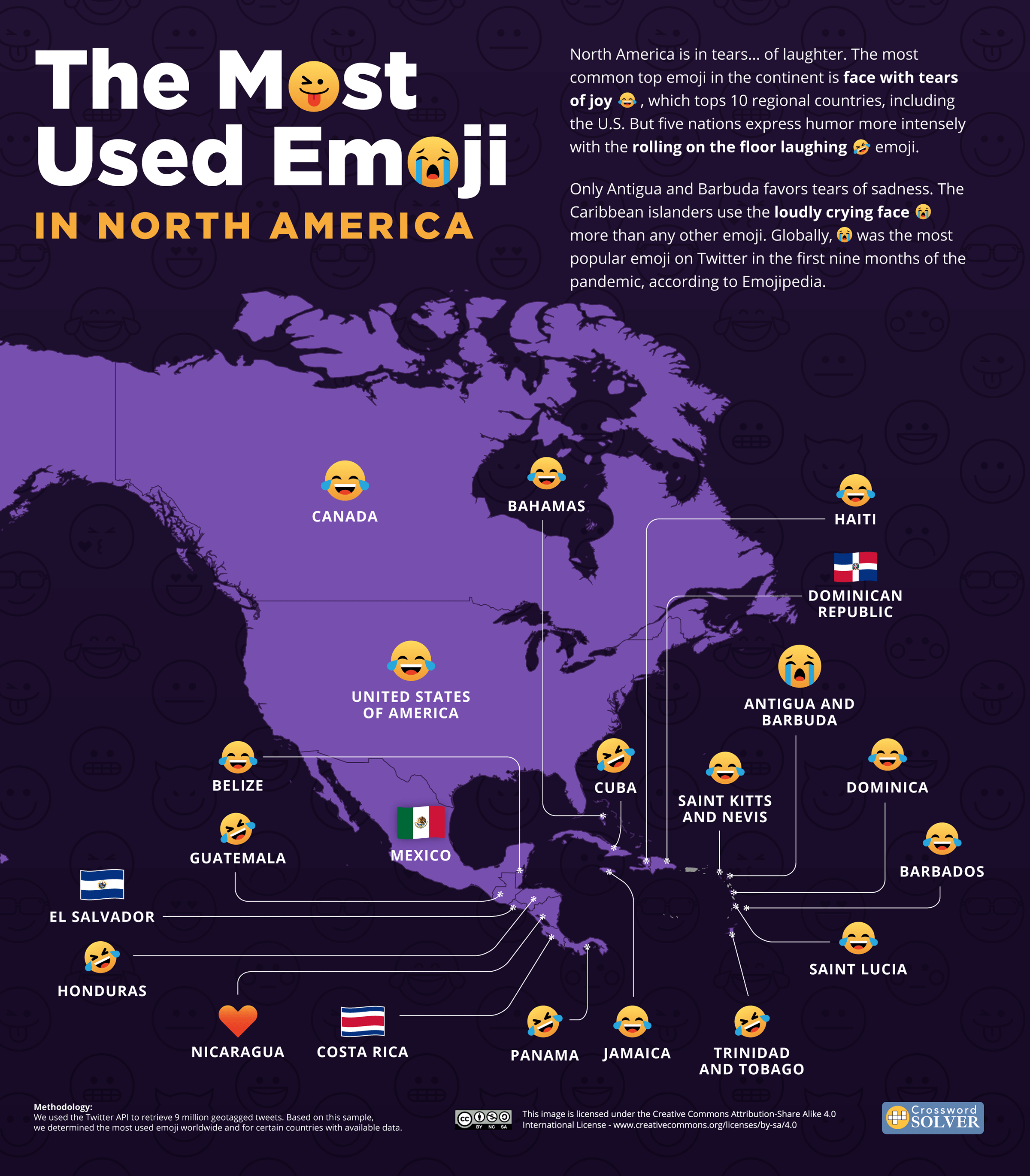
Laughter is the prevailing response across North America, with 10 countries using the tears of joy and another five one-upping them with the more extreme rolling on the floor laughing emoji. Nicaragua is the only country not to feature tears or a flag, favoring the red heart.
South America
Guyana and Bolivia lead with national pride in South America, each tweeting out their respective national flag more than any other emoji. The world favorite (face with tears of joy) claims just one South American territory, pipped by rolling on the floor laughing, which is how Chile and Paraguay feel.
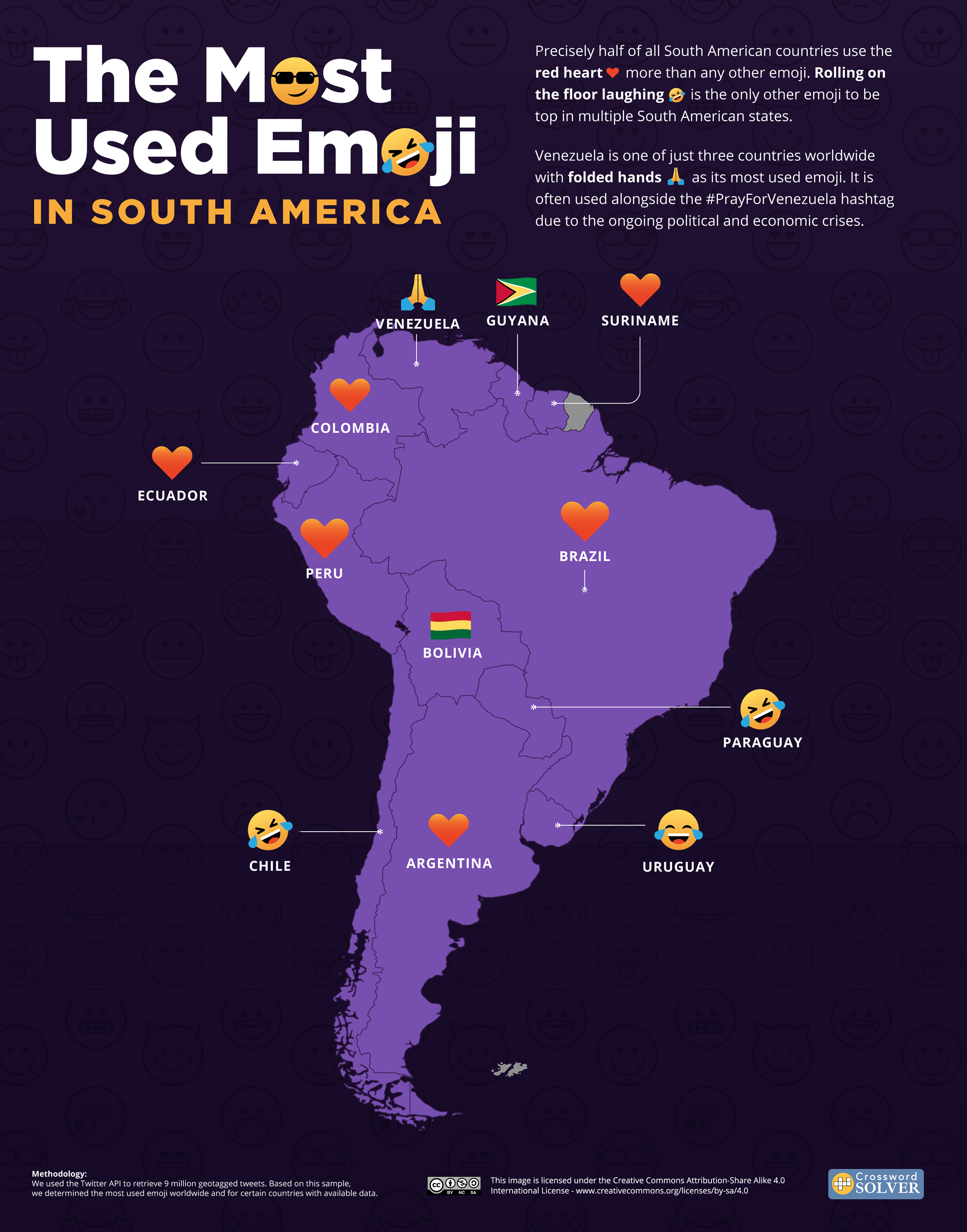
The most common top emoji in South America is the red heart, which is also the second most common top national emoji worldwide. In its guide to deciphering 20+ different heart emojis, Cosmo points out that the red heart is a little basic – and not recommended for use more than once when aimed at an actual lover and not the whole of Twitter.
Europe
Europe is big on flags, with 19 out of 51 countries tweeting a national flag more than any other emoji. However, Poland is the only country not to tweet its own, instead sharing the Ukrainian flag the most during our sample period – which coincided with the start of the Russian invasion of Ukraine.
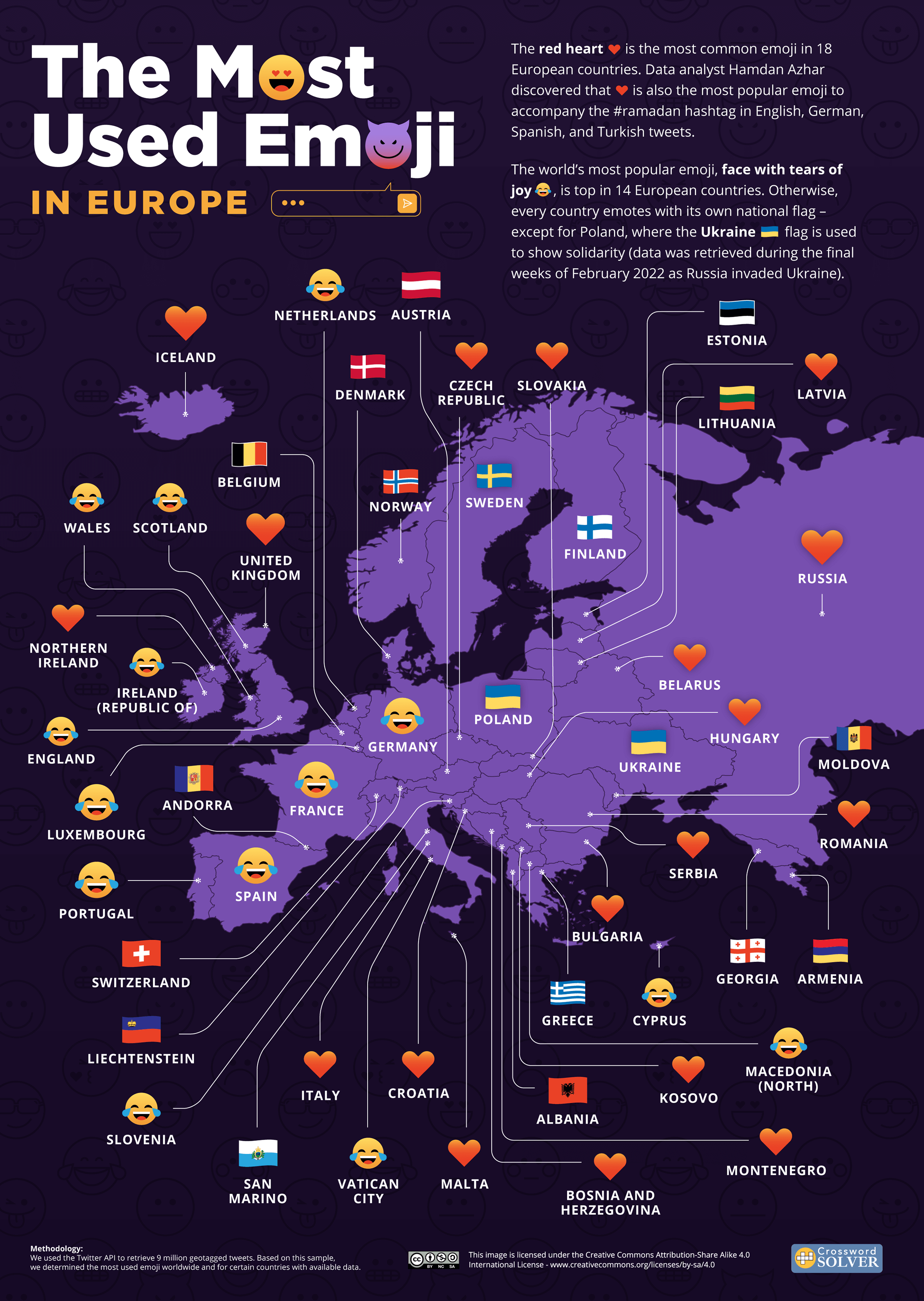
Flags aside, Europe is all red hearts (18) and faces with tears of joy (14). But the latter, despite being world number one, could soon be a victim of natural selection. “I stopped using it a while back because I saw older people using it, like my mom, my older siblings and just older people in general,” one Gen Z-er told CNN Business. Younger generations prefer the skull or coffin emoji to connote “I’m dead” (laughing).
Middle East & Central Asia
The pushpin is a deadpan emoji. It has become the centerpiece of many a meme, generally marking the stopping points on the tweeter’s journey, from good intentions to a personal fail. Kuwait is the only country in the world where the round pushpin is the most commonly used emoji. However, Kuwaitis mostly use the pushpin as a conspicuous way of tagging a location rather than to solicit eye-rolls.
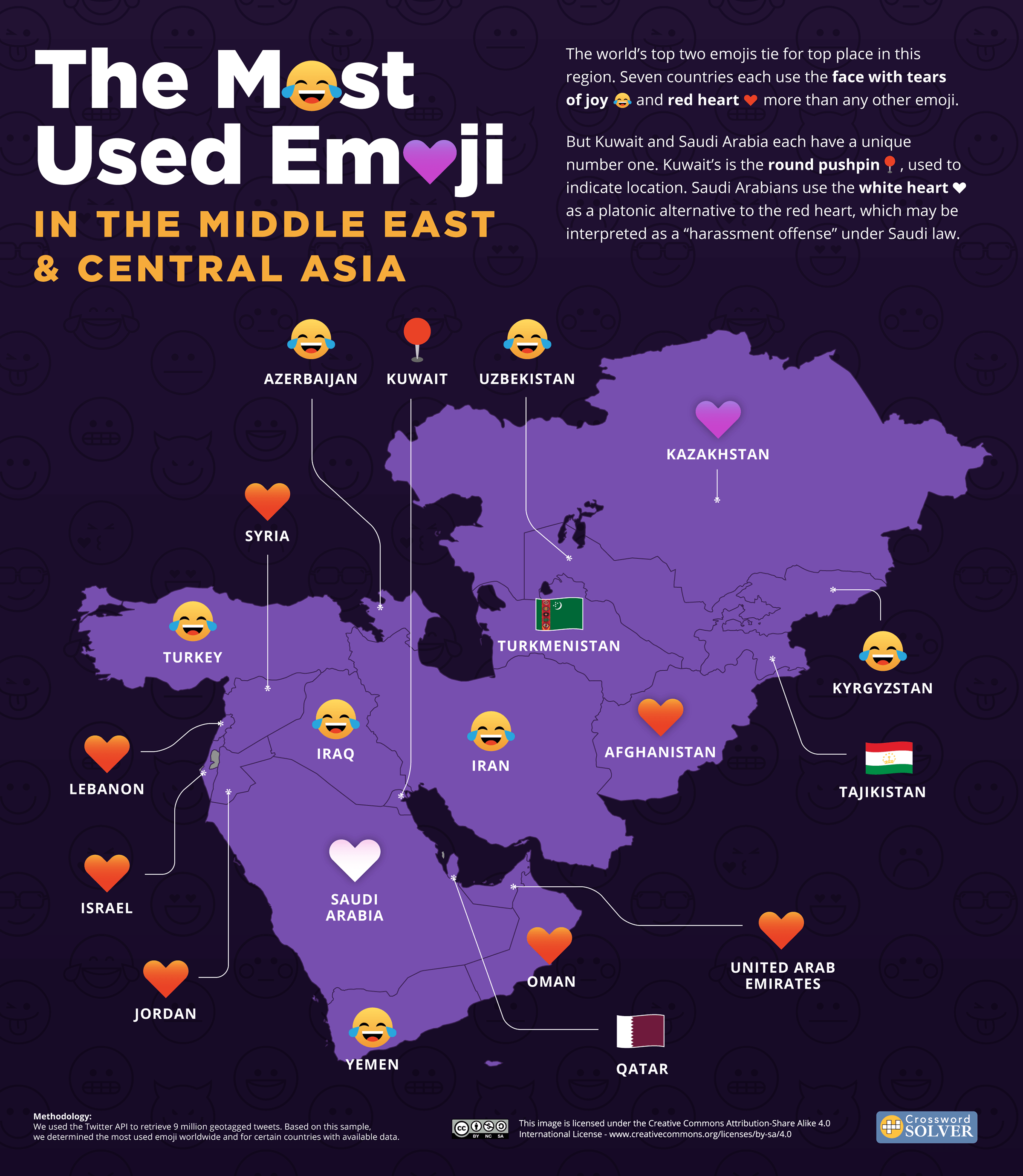
In Saudi Arabia, sending a red heart can be considered a “harassment crime” in certain circumstances – leaving the offender with an SR100,000 ($26,656) fine and/or a two-year jail term. As such, the less racy white heart takes precedence as the top local emoji, making Saudi Arabia the only place in the world where the white heart is king.
Rest of Asia & Oceania
Japan has a greater selection of locally relevant emojis from which to choose than any other country. Examples include the dango candy and oni demon. Emojis first appeared on Japanese phones in the 1990s, and the emoji keyboard was first available on Japanese iPhones, so many Japanese icons were brought over to the Unicode standard.
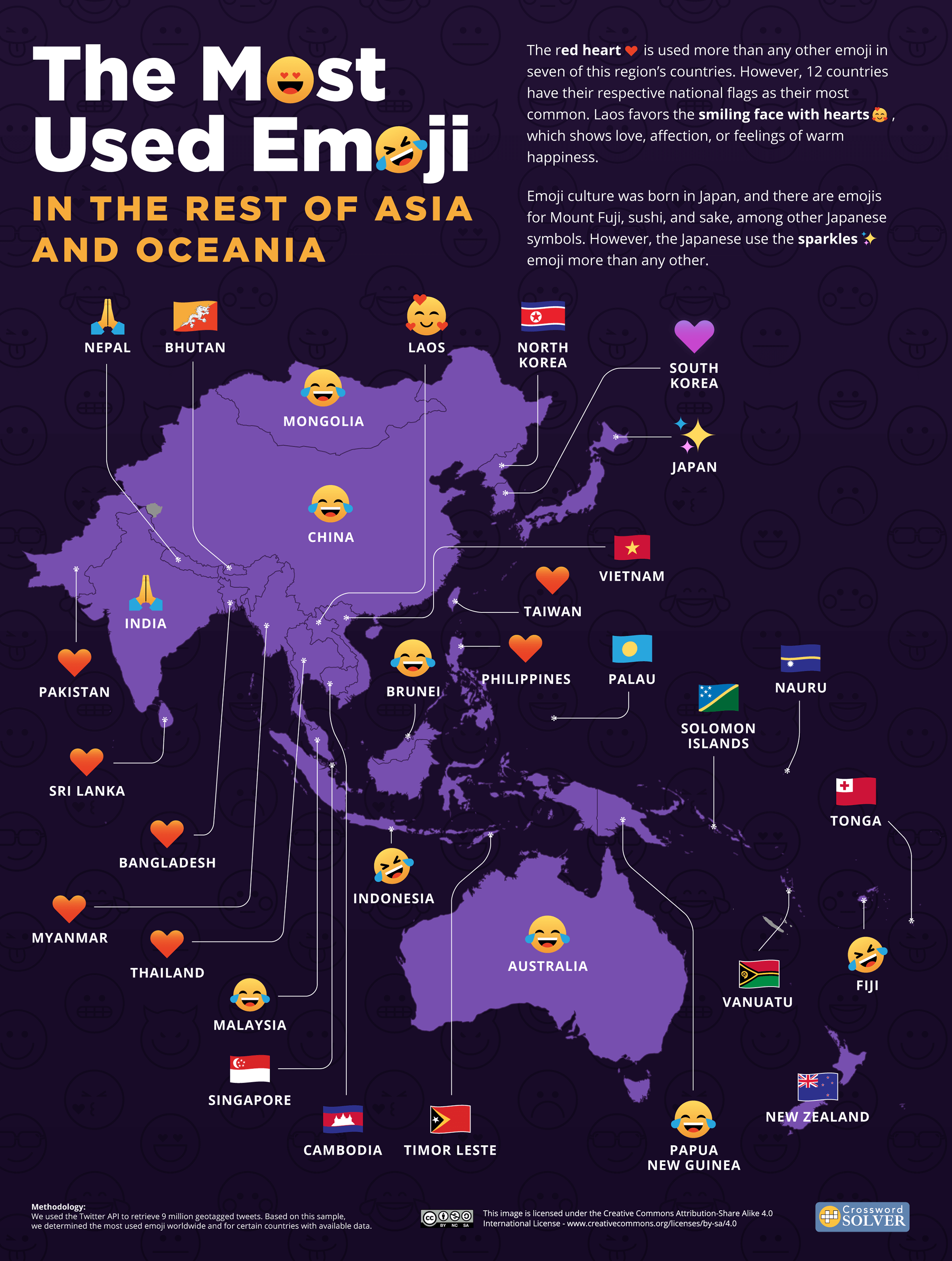
This sparkles emoji is one such ‘Japanese original’ that made it to Unicode, and it is now the most commonly used emoji on Twitter in Japan. Its Japanese roots may not be obvious, but sparkles was inspired by its likeness in manga and anime, where it denotes ‘shiny newness’ or attractiveness. However, today sparkles are just as likely to be used ironically around a sarcastic or mocking statement.
Africa
The face with tears of joy dominates in 37 of the 50 African countries with available data. A further 10 tweet their national flags more than any other emoji.
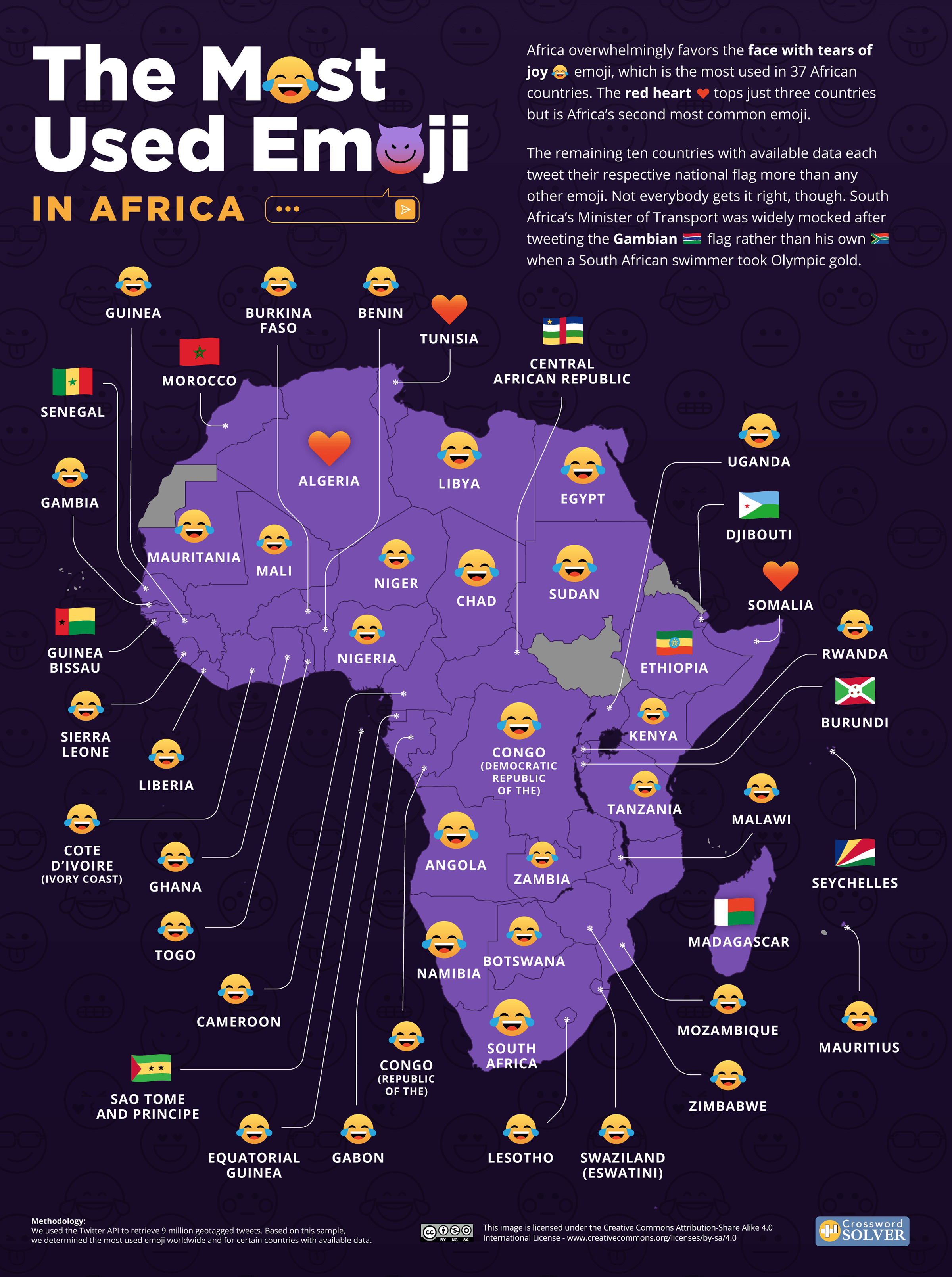
Algeria, Somalia, and Tunisia each tweet the red heart more than other emojis. In Algeria, the red heart tends to be divided between love for the phenomenal landscape – and love for the national soccer team.
The World’s Most Popular Emojis, Visualized
If real emojis grew in size with their popularity, the world would be a terrifying place. Thankfully, the graphic below is just a data visualization demonstrating how the world’s most commonly used emojis would look if their size were related to their use. The face with tears of joy is the giant of international emoji use. It even became the only picture to be Oxford Word of the Year, with Oxford University Press calling it “the ‘word’ that best reflected the ethos, mood, and preoccupations of 2015.”
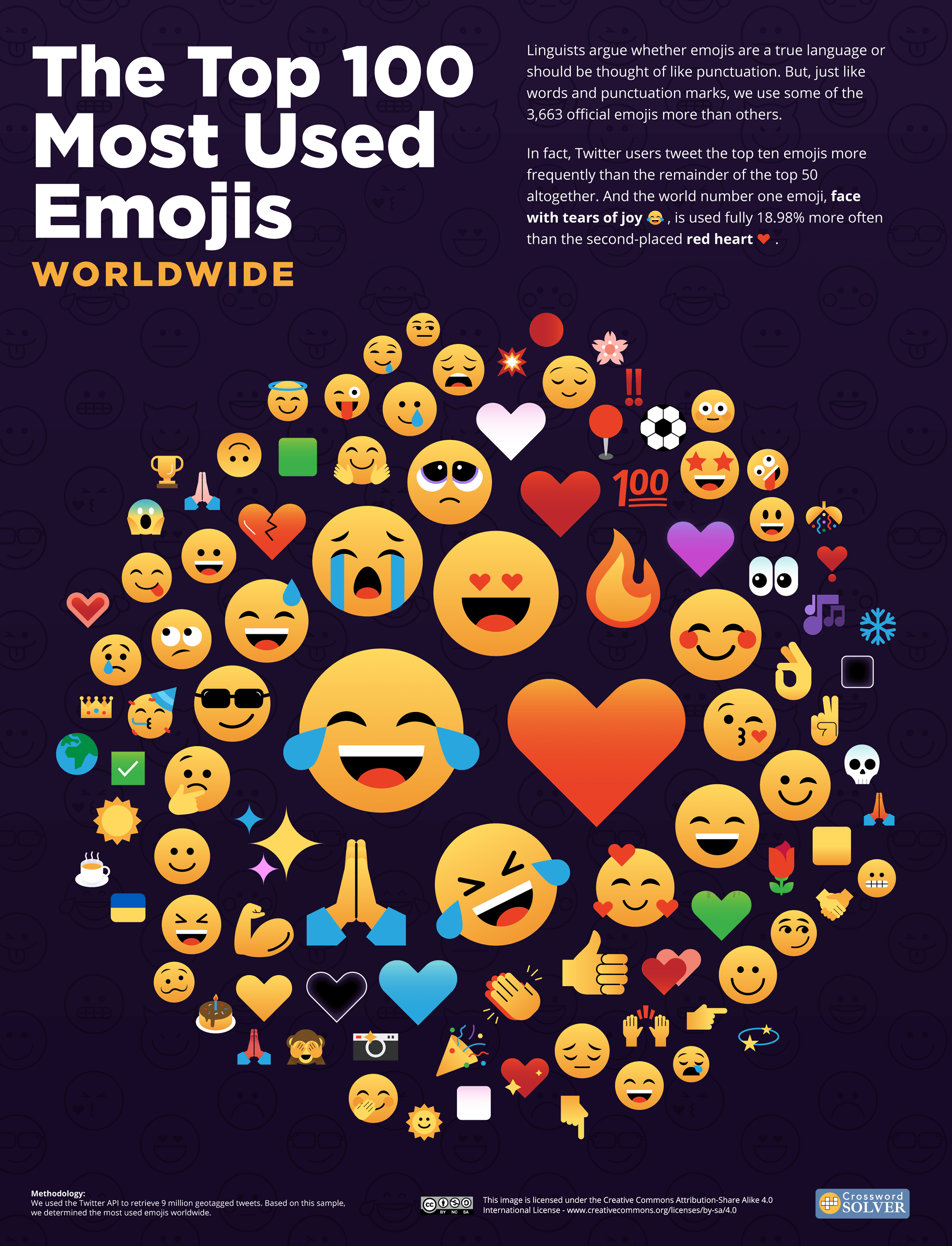
There are 3,663 official emojis, but the most popular are a lot more popular than the rest. Face with tears of joy is used nearly twice as often as third-most-popular rolling on the floor laughing, which is in turn twice as common as the folded hands emoji – which is sixth most used. However, there are efforts to make emojis more diverse. Different skin colors were first made available in 2015, while the pregnant man and pregnant person emojis are among the latest additions.
Every U.S. State’s Defining Emoji
The face with tears of joy emoji is most common across America, so we checked which emoji each state uses at a higher than average rate. The following map shows how 22 states drag up the average use of the world’s favorite emoji. Only Idaho (folded hands), Wyoming (smiling face with heart-eyes), and New Hampshire (snowflake) have a unique ‘most unique’ emoji.
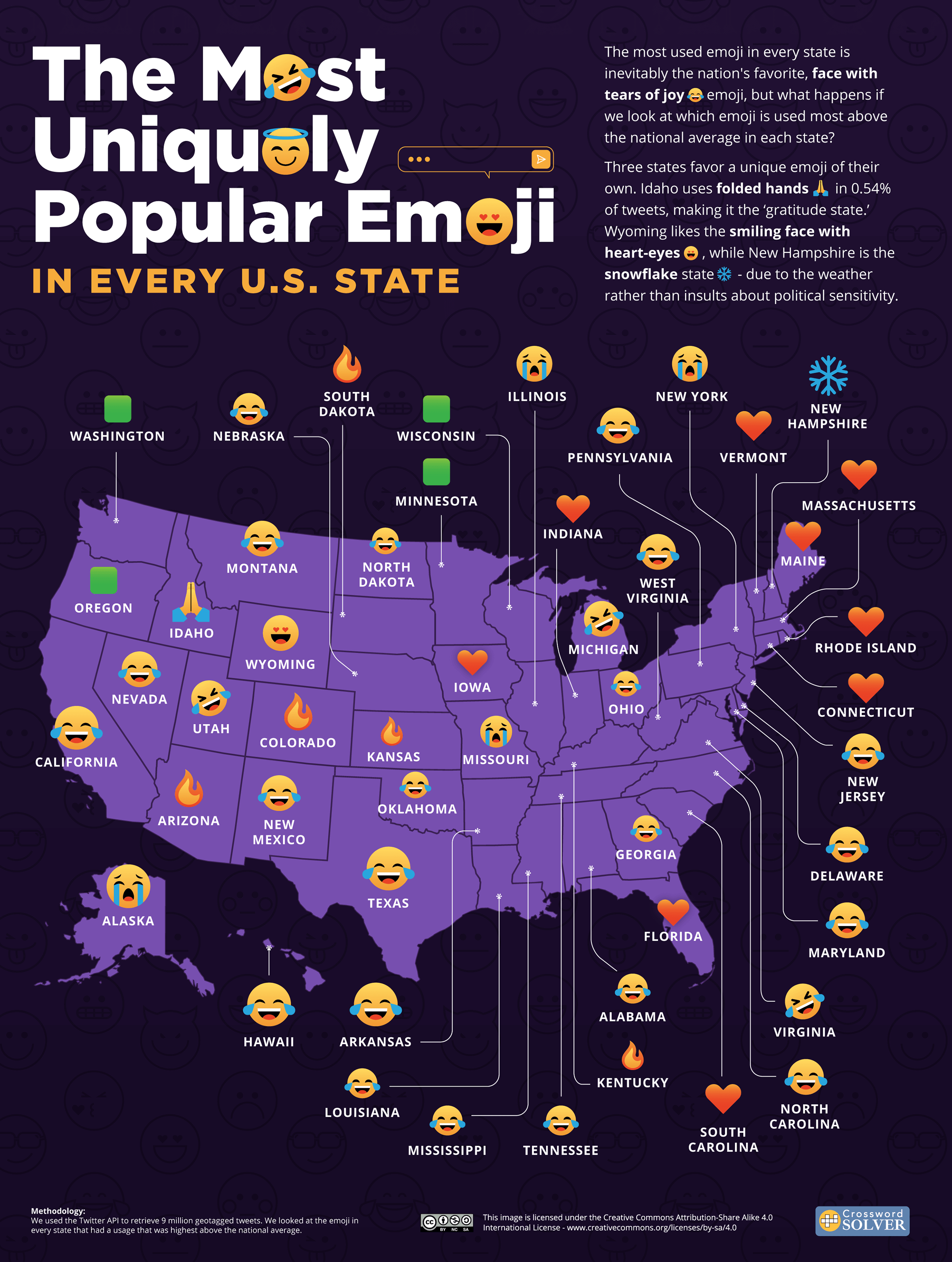
Countrywide, Americans use the fire emoji 0.79% of the time – but five states use the flame at a higher average rate than any other emoji. In some usages, the fire emoji means ‘lit’ (itself slang for “very good, enjoyable, or exciting”), hot (i.e,. sexy), or high/stoned. However, the top flame states include Colorado and Arizona, which are two of the most dangerous states for wildfires.
Wordle Emojis Take Over U.S. Twitter
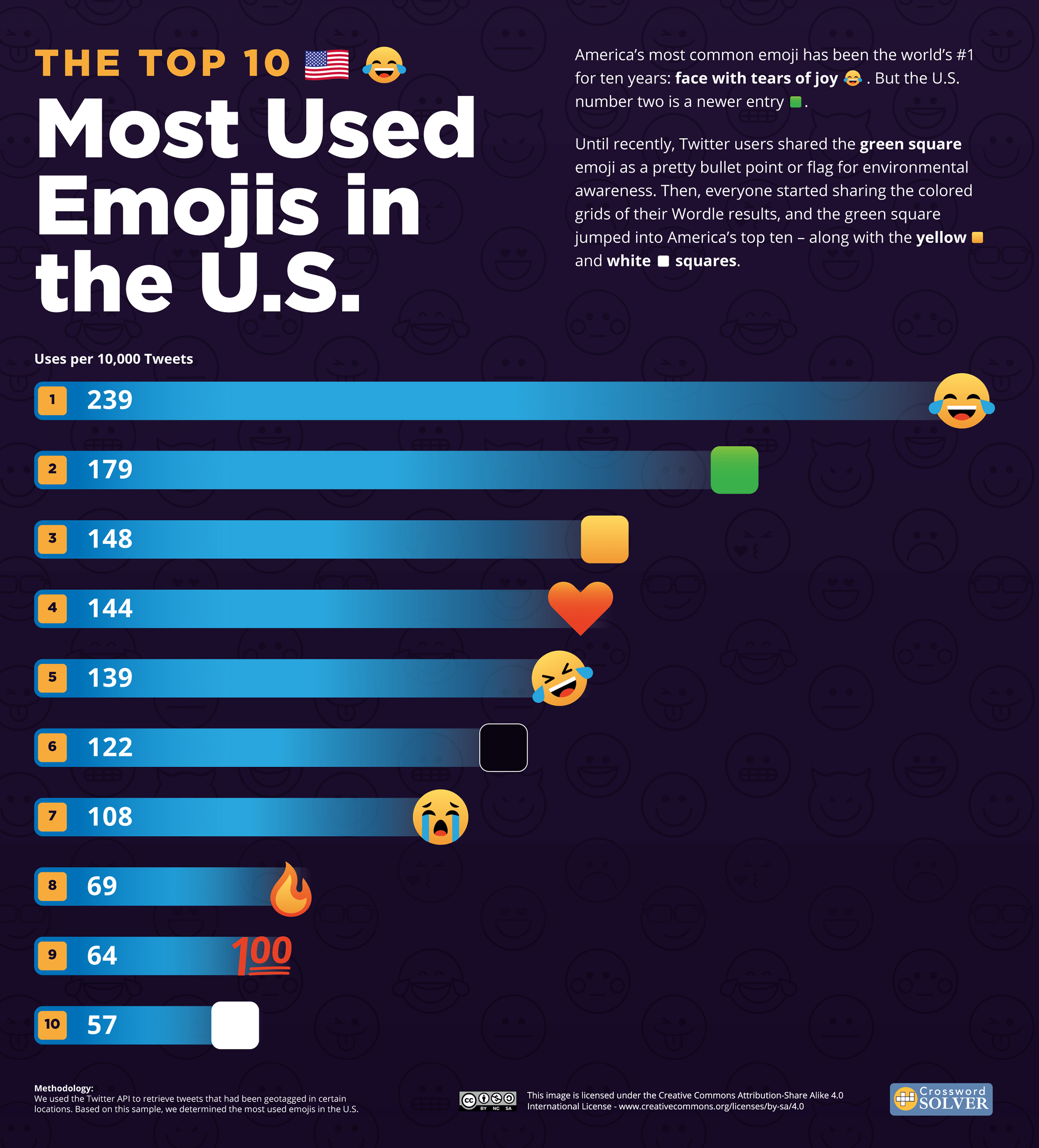
You’ve seen them, even if it took a while to figure out what they are. Grids of green, yellow, and white squares began appearing on Twitter at the end of 2021 as users reported their results on the word game phenomenon Wordle. By March 2022, there were 15 million such tweets – and the colored squares were all among the ten most commonly used emojis in the U.S.
Pandemic Effect on UK Emoji Usage
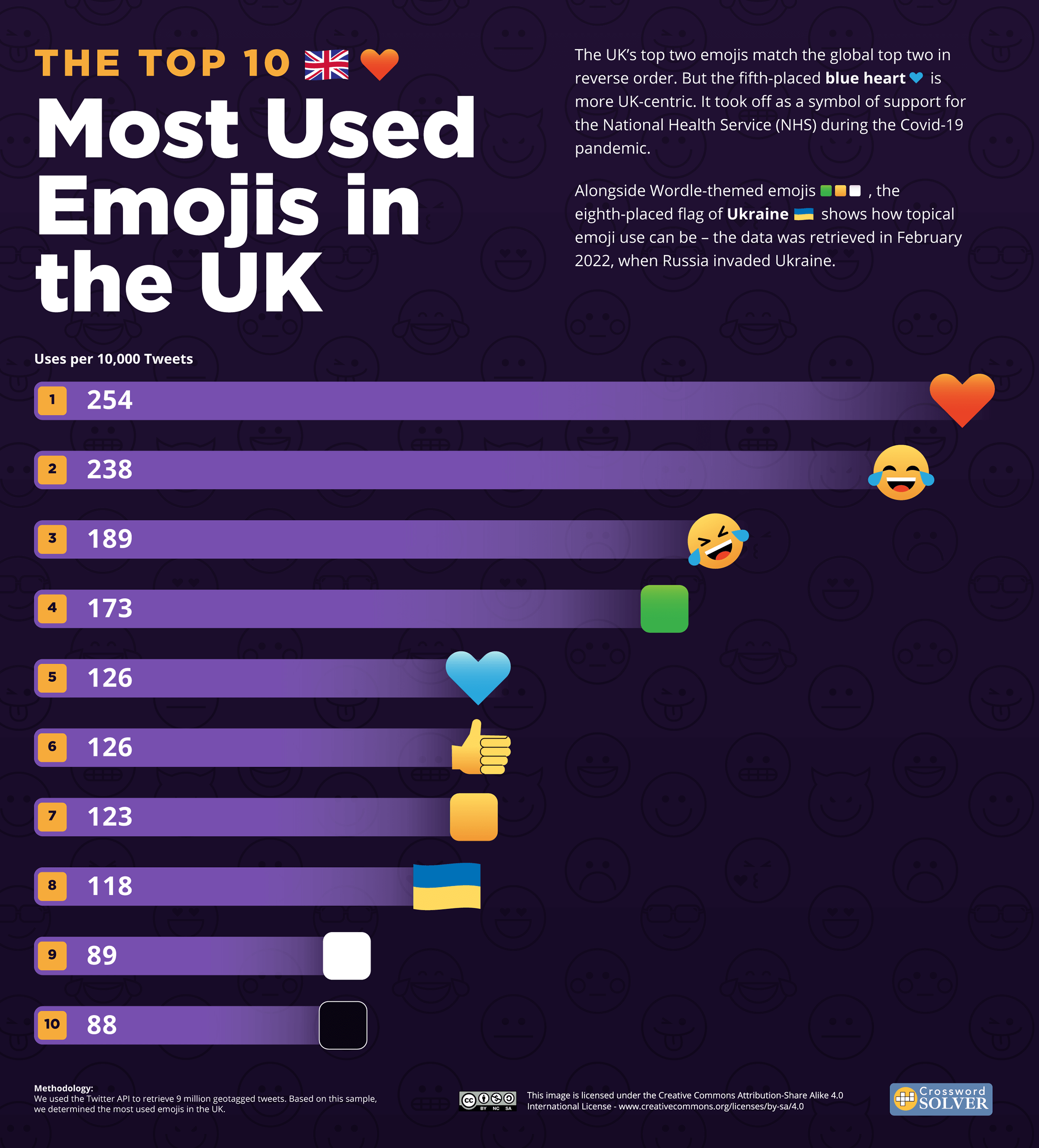
The UK’s top 10 emojis for February 2022 reflect the volatile nature of emoji use. At least half of them are used to reference contemporary events, including the three colored Wordle squares, the Ukrainian flag, and the blue heart – which took off as a supportive gesture for the National Health Service in the first weeks of the Covid-19 pandemic.
An International Language of Gestures
A picture may say 1,000 words, but an emoji captures a precise feeling according to an internationally recognized lexicon. More than a punctuation mark and parallel to written language, a well-chosen emoji packs a punch as a gesture– enriching written communication and lending it some of the tone and nuance that is lost from face-to-face or phone conversation.
But just as every place has its own gestures and its own take on some of them, the emoji has taken on its own life around the world. To find where each emoji is most commonly used, please check through our interactive table below.
Bonus Graphics: The Top Ten Most Used Emojis in Canada and Australia
Not included in the original article are the graphics for the top ten most used emojis in Canada and Australia…
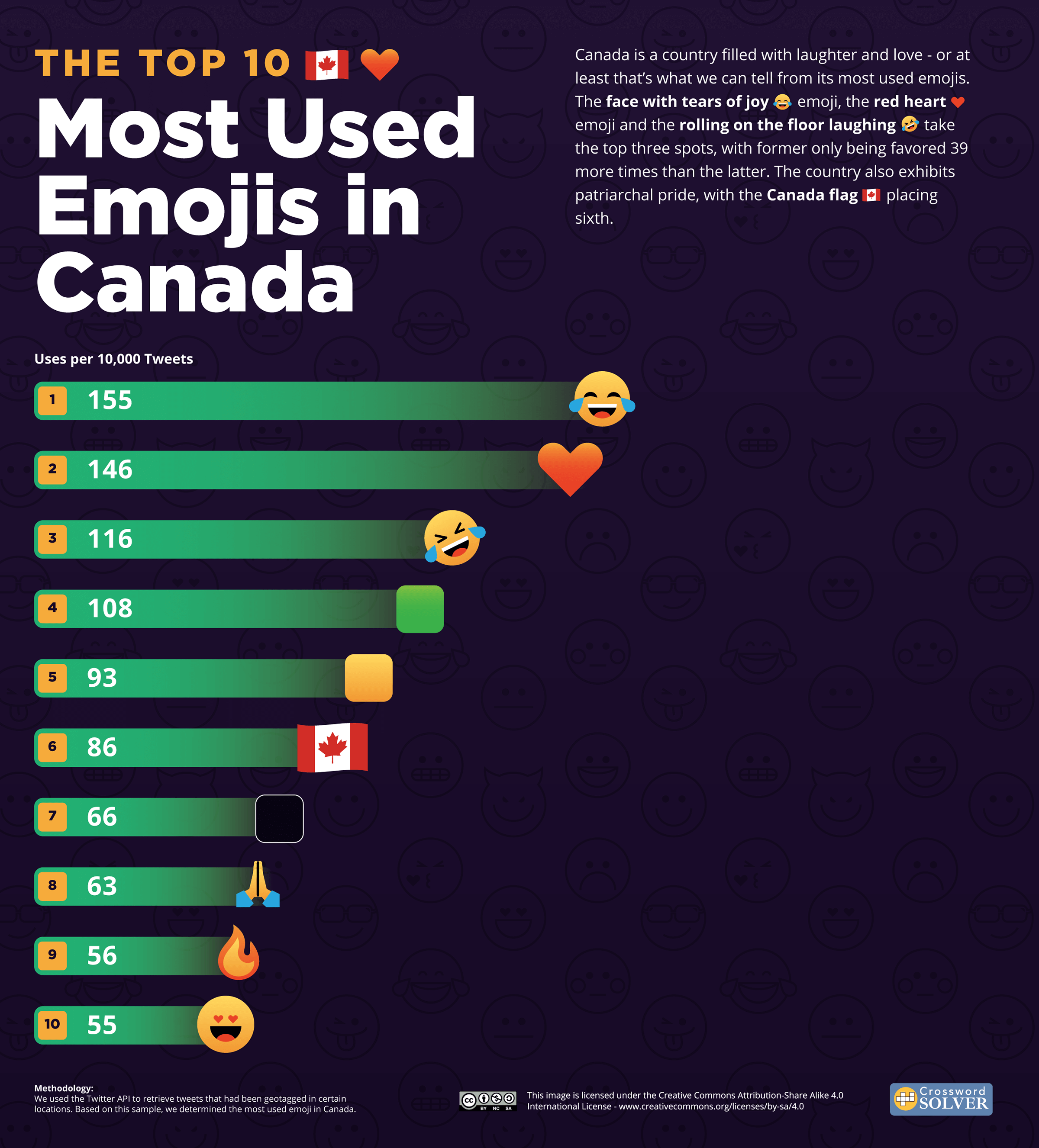
…and in both countries, the face with tears of joy emoji was the most used — followed by the red heart in second place.

Final Boarding Call
I have had a theory for years about the emoji with the simple smiling face 🙂 as it has evolved throughout the decades: it was born as the smiley face in 1963. Once the popularity of the original smiley face waned during the last years of the 1970s, it resurrected its popularity as Pac Man — whose original Japanese name was Puck Man but was changed for international releases as a preventative measure against defacement of the arcade machines by changing the P to an F — in 1980 with its distinct profile of an open mouth as it hungered to eat ghosted monsters in a frenetic chase through a maze with edible white dots and the occasional fruit in the center. Once the Pac Man craze ended, it found a new life yet again as an electronic smiley in the 1990s and morphed into one of many emojis in the twenty-first century; and it is as popular today as ever.
That is my theory — and I am sticking to it. So there 😜.
Photograph ©2017 by Brian Cohen.

